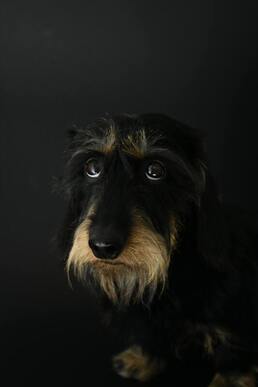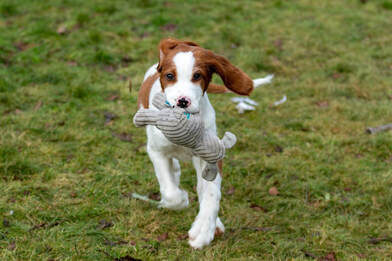|
I saw this quote on Facebook recently from Susan Friedman “The animal is never wrong…you get what you reinforce. All behaviour has a function including undesirable behaviour. The question is not “Why is the animal behaving this way?” but rather, “What’s reinforcing this behaviour?”
If we can think for our dog’s behaviour in this way, I really believe it would help us understand those behaviours that we wish they didn’t do. I talk to lots of people who get really distressed that their dog does a certain behaviour, and they think the dog understands this behaviour is wrong. I hear “they knew they shouldn’t be doing that”. Let’s just be clear – dogs are not moral; they have no concept of right and wrong. They view the world as what works and what doesn’t. what’s safe versus what’s dangerous. As Susan Friedman says, “all behaviour has a function”. So the real question you should be asking yourself is “what is the dog achieving from doing the behaviour?”. “What is reinforcing it so that they repeat it?”. Let’s talk through some examples: Your dog is jumping up on your kitchen table. Sometimes when it jumps up something is there to grab, crumbs from your toast, a smelly tea towel, or even loaf of bread. Can you see that the action of them jumping up is being rewarded by the ‘thing’ they get. Now what usually happens is that you now catch your dog in the action of jumping up, you tell them off or correct them in some way, they stop doing it. You think they have learnt not to do it. However you notice that they still do this behaviour when you are not home as you find evidence of things chewed up when you return home. You now think your dog is doing this on purpose – they knew they shouldn’t be doing it; they are doing it to spite me. No! They have learnt that doing that behaviour when you are present is dangerous (there is a consequence) but when you aren’t home, it’s safe so that’s when to do it. This is smart right? It’s safe when no one is around so that’s when they do the behaviour. It gets reinforced because sometimes they win something like some left over food. Let’s think of another example. Your dog is worried about other dogs getting too close, so they have started to bark when another dog approaches. Most of the time, the owner of the other dog will move their dog away (as barking is intimidating) so now the barking dog sees their behaviour as successful. After a few repetitions they have learnt that barking keeps them safe as the other dog moves away. Even if this barking behaviour doesn’t work every time, it work’s often enough that it is seen to be successful and therefore the function of barking has achieved the goal of making the other dog move away. Once a behaviour is learnt then why would the dog change it? It works! Behaviour will only change if you consider the function, the ‘why’ of the behaviour is happening and what is reinforcing it? Only then can you look to change the behaviour. Have you ever tried to change your behaviour before? Something that you have done for a long period of time. It’s hard work and takes time. Sometimes figuring out the ‘why’ needs a different viewpoint and not from someone in the middle of it. I am very happy to tell you when I struggle with my dog’s behaviour, I seek help from others. People I trust that can help and guide me to achieve the best outcome for me and my dog. There is nothing wrong with asking for help. If you have got to the point where you need help and support for your dog’s behaviour and to understand their ‘why’ then please get in touch. Jo x
0 Comments
It may surprise you that as a trainer I haven’t started doing much training with Bramley yet. We have had him 6 weeks, and in terms of obedience training, he knows sit (the breeder started that) and to respond to his name, so the start of recall training. That’s it. I think this will surprise some people.
With any new dog (puppy or rescue) the last thing I focus on is obedience training in those first few months. Don’t get me wrong, I start working on manners such as where to toilet, reducing puppy biting, confident in being handled and showing them how much fun playing with me is. My focus is on finding out who this dog is, what they enjoy doing, working on building confidence in the world around them (noises, different environments, people, dogs etc) but mainly it’s all about building a trusting relationship. I love all the training side, and he will learn lots of skills, but you cannot expect a dog to enjoy training and learning without the fundamentals of having a relationship first. Our main focus with Bramley at the moment is raising a confident dog. We met our target of meeting 100 people before he was 12 weeks old (Ian Dunbar recommends this amount) which took lots of planning and carrying him around and having people in our house. He has meet several of our friends’ dogs before he was allowed out to interact with others. We have been to garden centres, B&Q, housing estates, rural walks, woods, riverside walks, seen some horses and sheep. Lots of trips in the van, which he is now happy to travel in. Working on being left alone, and appropriate play with the other 2 dogs. I have goals of what I want him to be good at as an adult and what experiences I don’t have easy access to – this shapes what we do each week. I need to be proactive in what we are doing but also being aware to not overwhelm and give him space to process. The joyful moments we now have with him and Hallie playing together is lovely. We had to do a slow introduction to start with as Hallie can guard me and stuff on the floor, so management is needed. However, they are building a lovely bond together and figuring out how to play. Cuba isn’t that interested but as he is 9, I wouldn’t expect him to be. I think when Bramley is less bouncy their relationship will build. I will keep you all updated with what we get up to as he grows up. The joys of adolescence will be on us in no time!!! Jo x |
Archives
June 2024
|
|
© COPYRIGHT Paws4teaching 2023
Terms and conditions |





